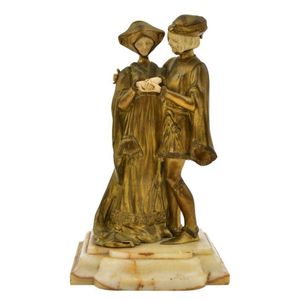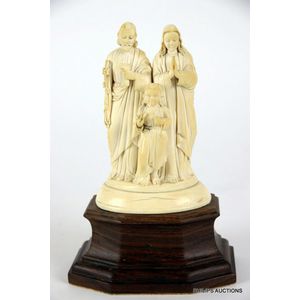Antique Ivory Holy Family Group
You must be a subscriber, and be logged in to view price and dealer details.
Subscribe Now to view actual auction price for this item
When you subscribe, you have the option of setting the currency in which to display prices to $Au, $US, $NZ or Stg.
- Ivory - Ivory is a hard white material that comes from the tusks of elephants, mammoth, walrus and boar, or from the teeth of hippopotamus and whales. The ivory from the African elephant is the most prized source of ivory. Although the mammoth is extinct, tusks are still being unearthed in Russia and offered for sale.
Ivory has been used since the earliest times as a material for sculpture of small items, both in Europe and the east, principally China and Japan.
In Asia ivory has been carved for netsuke, seals, okimono, card cases, fan supports, animals and other figures and even as carved tusks.
In the last 200 years in Europe ivory has been used to carve figures, for elaborate tankards, snuff boxes, cane handles, embroidery and sewing accessories, in jewellery and as inlay on furniture. Its more practical uses include being used for billiard balls, buttons, and a veneers on the top of piano keys.
The use and trade of elephant ivory have become controversial because they have contributed to Due to the decline in elephant populations because of the trade in ivory, the Asian elephant was placed on Appendix One of the Convention on International Trade in Endangered Species (CITES), in 1975, and in January 1990, the African elephant was similarly listed. Under Appendix One, international trade in Asian or African elephant ivory between member countries is forbidden. Unlike trade in elephant tusks, trade in mammoth tusks is legal.
Since the invention of plastics, there have been many attempts to create an artificial ivory
This item has been included into following indexes:
- religious objects, Christian
Visually similar items

A soapstone figure of Guanyin and stand late Qing dynasty, (2), seated in lalitasana wearing a loose robe draped as a cowl over a high chignon picked out in black, incised and gilt with cloud and floral motifs and scroll borders, a censer exhaling clouds t

A French late 19th century carved ivory group figure, probably Dieppe, depicting a courting couple of dignitaries in late 17th century dress, set upon an ivory cylindrical plinth, 21 cm in high

An Art Deco cold-painted bronze and ivory figural group, Louis Sosson, modelled as a female and male embracing with their hands clasped, each wearing traditional medieval costume, the hands and faces carved from ivory, mounted on a stepped alabaster base,

Ivory carved figure group of Krishna & Radha depicting the elaborately garbed figure of Lord Krishna depicted standing on rockwork holding a staff, the kneeling figure of Radha reaching to embrace him. Mounted on a rosewood base. Condition: good to fair, m
